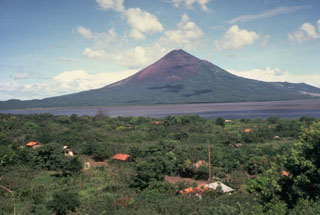Report on Momotombo (Nicaragua) — April 1990
Bulletin of the Global Volcanism Network, vol. 15, no. 4 (April 1990)
Managing Editor: Lindsay McClelland.
Momotombo (Nicaragua) Fumarolic activity
Please cite this report as:
Global Volcanism Program, 1990. Report on Momotombo (Nicaragua) (McClelland, L., ed.). Bulletin of the Global Volcanism Network, 15:4. Smithsonian Institution. https://doi.org/10.5479/si.GVP.BGVN199004-344090
Momotombo
Nicaragua
12.423°N, 86.539°W; summit elev. 1270 m
All times are local (unless otherwise noted)
When visited 21 and 27 April 1990, locations of fumarolic vents had changed little since a year earlier but gas temperatures had generally declined by 50-150°C. The highest recorded at vent F9 was 772°C (down from 880° on 15 April 1989) and temperatures at neighboring vents were 634° (779° in April 1989), 662° (716° in 1989), and 742° (844° in 1989). Other temperatures measured on 27 April 1990 were 575°C (F7), 702° (F8), and 439° (F12). Small dribbles, drops, or pools of amber-colored liquid sulfur were common at most fumaroles. Some very small multiple flows had smooth crusts of solid orange-brown sulfur, which turned bright yellow within minutes of removal from the hot surface. At F8, a tiny pool of liquid sulfur, a few mm deep, had a temperature of 137°C. Evidence for older, larger, sulfur flows included eroded remnants as much as 15 cm thick near F12, where up to 5 m of a pahoehoe type flow was preserved, including its front. The upper portion had apparently been eroded by water.
Geological Summary. Momotombo is a young stratovolcano that rises prominently above the NW shore of Lake Managua, forming one of Nicaragua's most familiar landmarks. Momotombo began growing about 4500 years ago at the SE end of the Marrabios Range and consists of a somma from an older edifice that is surmounted by a symmetrical younger cone with a 150 x 250 m wide summit crater. Young lava flows extend down the NW flank into the 4-km-wide Monte Galán caldera. The youthful cone of Momotombito forms an island offshore in Lake Managua. Momotombo has a long record of Strombolian eruptions, punctuated by occasional stronger explosive activity. The latest eruption, in 1905, produced a lava flow that traveled from the summit to the lower NE base. A small black plume was seen above the crater after a 10 April 1996 earthquake, but later observations noted no significant changes in the crater. A major geothermal field is located on the south flank.
Information Contacts: C. Oppenheimer, Open Univ; Benjamin van Wyk de Vries, INETER.

